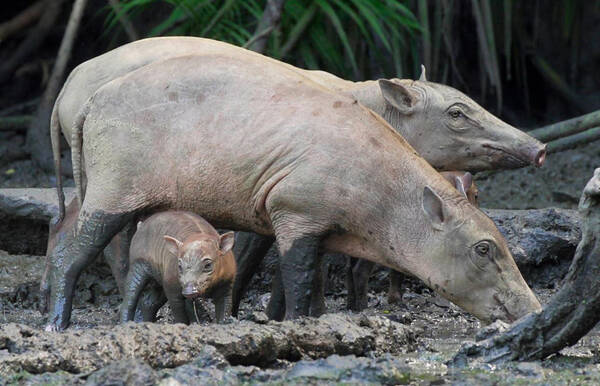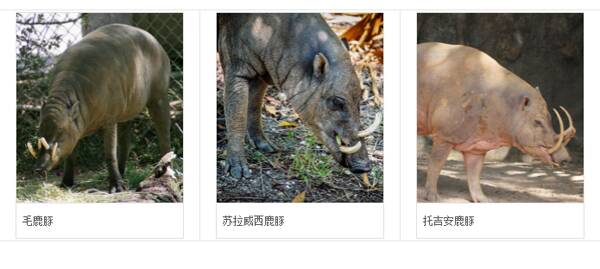Babyrousa celebensis
IUCN
LCBasic Information
Scientific classification
- name:Babyrousa celebensis
- Scientific Name:Babyrousa celebensis,Kalowatan,Celebes Babirusa, Togian Babirusa
- Outline:Ungulata
- Family:Artiodactyla Suidae Babirusa
Vital signs
- length:85-110cm
- Weight:60-100kg
- lifetime:About 23 years
Feature
Almost no hair on the body
Distribution and Habitat
The Sulawesi babirusa is endemic to Indonesia and is widely distributed on Sulawesi, except in the southwest of the peninsula, and also on offshore islands including Muna, Buton and Lembeh. In the northern peninsula of Sulawesi, the species has disappeared in the extreme northeastern part, and their distribution may be mainly limited to the western end of Bogani Nani-Wartabone National Park, Nantu Wildlife Sanctuary, Panua Nature Reserve, and the western region. The remaining forests in Randangan (Pohuwato Regency) and Buol Toli-Toli Regency; all of Gorontalo Province, Pohuwato Regency, these are in the western half of the peninsula.
The Sulawesi Babirusa inhabits undisturbed forests on the Indonesian island of Sulawesi, including evergreen rainforests, riverine forests, and swamp forests. Macrocarpon trees are an important component of the habitat. It mainly inhabits rivers and ponds in tropical rainforests that have abundant aquatic plants. Although the animals used to occur in lo
Appearance
The Sulawesi Babirusa has a head-body length of 85-110 cm, a shoulder height of 58-65 cm, a tail length of 20-30 cm, and a weight of 60-70 kg for females and up to 100 kg for males. They have a typical pig body shape, with a barrel-shaped body and a long face. The back is arched and the hind legs are relatively long. Unlike other members of the genus Babirusa, this species has very sparse short hair on its body, wrinkled skin, and an overall gray color. The color of the body surface may vary depending on the species' habit of rolling in the mud. The tail is long, with a tuft of sparse hair at the tip. The elongated cheeks have a pointed "pig nose" at the front, and the ears are small and leaf-shaped. Males are easily recognized, they have white tusks. The lower canines extend vertically from the lower jaw and curl backwards, and the upper canines are rotated on the skull so that these teeth also grow upwards, piercing the facial skin and curling backwards. Females lack t
Details
Sulawesi Babirusa (scientific name: Babyrousa celebensis) is called Kalowatan in foreign language, and has no subspecies.

Sulawesi Babirusa consists of small groups of one or two adult females and their offspring, most of which are females with young animals. Groups rarely exceed 5, but groups of up to 13 have been observed in the rainforests of northern Sulawesi. Adult males are usually solitary, but have been seen accompanying groups of females or in small groups of 2-3 males.
Sulawesi babirusa are diurnal, foraging in the morning and afternoon and resting at noon. In zoos, babirusa will gather some material and make a nest to spend the night. In the wild, Sulawesi babirusa will go to open swamps to lick mineral salts. These wild pigs are good swimmers. They mark their territory with scent, rub against trees, and plow in the mud. Although Sulawesi babirusa have a medullary disk like other babirusa, they do not dig on hard ground and under vegetation, only detecting soft substrate soil. They may follow their group and look for fruit that has fallen from the tree canopy.
Male Sulawesi babirusa enforce social hierarchy by lifting their heads upwards in a display of strength. If opponents are not deterred, it can escalate into a "fight", where two males support themselves on their hind legs and threaten each other with their front feet. The bizarre tusks do not participate in the fight, as the superior male presses his head on top of the submissive animal's head, which protects the dominant male from being stabbed by the lower canines of another male. Females establish their rank by prodding at the opponent's front legs. Vocalizations include screams, low purrs and growls, and females use a "clucking" sound to call their young.

Like most other wild pigs, the babirusa is omnivorous, with both wild and captive individuals consuming a wide variety of plant leaves, roots, and fruits, as well as animal matter, including invertebrates and small vertebrates. In studies of wild Sulawesi babirusa and captive animals, review information is available, and their stomach and digestive capacity, from an anatomical and digestive perspective, are most likely non-ruminant, with foregastrous fermentation of fruit or enrichment selection. The jaws and teeth of the Sulawesi Babirusa are reportedly strong enough to crack very hard nuts easily. However, due to the lack of a prominent medullary bone in the snout, the species does not exhibit typical behavior of other wild pigs. They simply thrust their protruding snout into soft sand and wet, muddy soil to search for food. Food consists of fallen fruits and leaves. Herbs, grasses, roots, and animal matter (invertebrates and small vertebrates) may comprise a smaller portion of the diet.
The Sulawesi Babirusa can breed year-round, with a gestation period of 155-166 days. Expectant mothers gather vegetation and material to build a den in which they can give birth. The litter size is 1-2, rarely 3. The precocious young are born without stripes or other markings, which is unusual in other wild pigs. The weight at birth is about 750 grams. Females lie down while nursing. The young develop quickly, beginning to sample solid food 10 days after birth, and the weaning period is at least 5 months. Both sexes of Sulawesi babirusa reach sexual maturity within 10 months in captivity, while those living in the wild may reach maturity within 1 year. It is not exactly documented when the young leave the group, but females may stay to accompany the young of the previous litter. Lifespan is up to 23 years.
The Sulawesi babirusa is easily distinguished from the hairy babirusa (Babyrousa babyrussa) and the Togean babirusa (Babyrousa togeanensis) because it has almost no hair on its body.

Babirusa are sold as food to supply Christian markets in North Sulawesi. As the species becomes rare or non-existent in the eastern part of the northern peninsula, hunting is moving westward and centrally. For example, babirusa from the northern region of Palu and Lorelindu National Park are being hunted and sold to traders from North Sulawesi. In more coastal areas, some Sulawesi babirusa are deliberately trapped for the Balinese mask-making trade. Balinese villages in coastal areas are also stimulating the "wild boar meat" trade. Across the island, the non-Muslim population is expanding, towns are growing, and restaurants are increasing in number and offering a wider range of services. The species is also threatened by the spread of commercial logging and other land uses, leading to forest conversion and degradation. In southeastern Sulawesi, there has been an expansion in the cultivation of commercial tree fruit crops. Wild boars in the forest are caught in traps set by hunters, killed and left to rot in the forest because local Muslim hunters trap them as vermin.
The Sulawesi Babirusa is estimated to number less than 10,000 individuals and is declining. They are fully protected under Indonesian law, but illegal hunting remains a major threat, even in protected areas such as Lore Lindu National Park and Bogani Nani Watarbone National Park. The Sulawesi Babirusa is part of the global One Plan conservation approach under the Action Indonesia umbrella.
Since 1931, wild boars have been given full protection under Indonesian law. The Sulawesi Babirusa is covered by Indonesian Law No. 5/1990, "On the Conservation of Biological Resources and Their Ecosystems". In 2013, the Indonesian government published a taxon-specific conservation strategy and action plan (Strategi Dan Rencana Aksi Konservasi Babirusa Tahun 2013-2022) (DKKH 2015). The National Action Plan identifies 11 priority conservation sites on the island of Sulawesi. The species occurs in several different levels of protected areas in Sulawesi (e.g. the western area of Bogani Nani Wartabone National Park, Nantu Wildlife Sanctuary, Lore Lindu National Park, Rawa Aopa Watumohai National Park, Panua Nature Reserve, Morowali Nature Reserve, etc.). Even in protected areas it is still under hunting pressure. The world captive population is 190 individuals in 34 institutions. In 2014 a Memorandum of Understanding was signed between the Indonesian Zoological Gardens Association (PKBSI), the European Association of Zoos and Aquariums (EAZA), the Association of Zoos and Aquariums (AZA), the Species Survival Commission (IUCN SSC), the IUCN SSC Asian Bison Specialist Group and the IUCN SSC Wild Boar Specialist Group (witnessed by the Indonesian Ministry of Environment and Forestry) agreeing to apply for the development of a Global Species Management Plan (GSMP) for species of the genus Babirusa (managed by the Association of Zoos and Aquariums (AAZA) in the Wolde area) and to jointly plan how ex situ populations and communities can best conserve this taxon within the framework of the Indonesian National Action Plan. The GSMP planning meeting was held in January 2016.
Listed in the IUCN Red List of Threatened Species in 2016 ver 3.1 - Vulnerable (VU).
Protect wildlife and eliminate game.
Maintaining ecological balance is everyone's responsibility!








